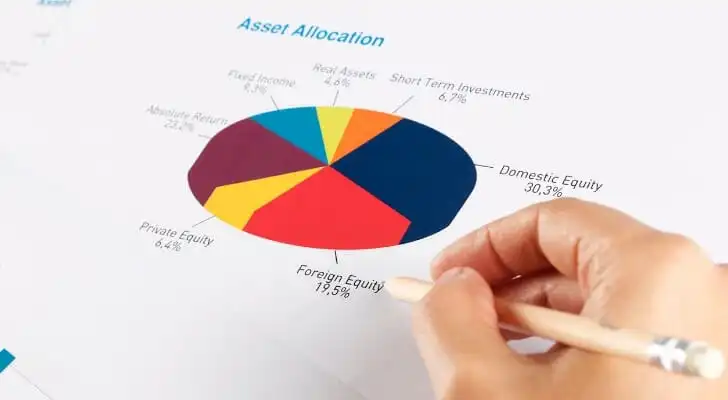
Setting up your asset allocation is one of the most crucial investment decisions that you will make for your portfolio. This is the process by which you break down your investment portfolio based on stocks, bonds, cash and other investments. Your age and risk tolerance will largely influence your strategy. In addition, your proximity to your retirement will also play a huge role. A financial advisor can help you develop a personalized strategy for your investment and retirement-planning goals and needs.
What Is Asset Allocation?
Before diving into the rules of asset allocation, it’s important to define what we mean. When you’re investing there are numerous classes, or categories, of assets that you may be working with. Some of the most important asset classes include:
- Equities such as stocks
- Fixed-income securities such as bonds
- Real estate
- Commodities
- Cash
This isn’t an all-inclusive list, but these categories are where most investors spend the majority of the time. Each asset class brings a different type of risk and potential reward. Some have the potential for huge returns during a strong economy but they could fall fast in a bad economy while other asset classes remain fairly steady over time.
Asset allocation is the act of diversifying your overall investment portfolio by distributing your assets into a variety of classes. This is done to limit the risk to your investments if a particular class happens to fall, but it allows you to take advantage of the potential returns of riskier asset classes.
The #1 Rule For Asset Allocation
One common asset allocation rule of thumb has been dubbed “The 100 Rule.” It simply states that you should take the number 100 and subtract your age. The result should be the percentage of your portfolio that you devote to equities like stocks.
As an example, if you’re age 25, this rule suggests you should invest 75% of your money in stocks. And if you’re age 75, you should invest 25% in stocks. The rationale behind this method is that young folks have longer time horizons to weather storms in the stock market. In theory, they would be safe to invest heavily in growth-oriented securities like stocks. Historically, equities have outperformed other types of assets in the long run.
But if you’re nearing or in retirement, you’d need your money sooner. So, it may make more sense to invest more heavily in securities such as fixed-income investments that are generally considered “safe.” We say that lightly as any investment carries some risk. Examples include:
- High-grade bonds
- Treasury bills
- Money market funds
- Cash
- Savings accounts
- Money market accounts
- Certificate of deposit (CD)
Life Expectancy and Asset Allocation
However, many investors believe certain factors mean The 100 Rule needs a bit of tweaking. For example, people are living longer — especially women. In fact, the Social Security Administration recently reported that the average 65-year-old woman can expect to live up to age 86.6.
For a wider context, the average life expectancy in the U.S. was just under age 79 in 2019. And a recent report from the U.S. Centers for Disease Control and Prevention (CDC) said that Americans living at age 65 could now expect to live another 18.8 years (almost 84), while those living at 85 could have a life expectancy of 6.7 more years (almost 92). This means that 25- and 30-year retirements are now more common.
A longer life expectancy means that you will need more money to fund a comfortable retirement. Theoretically, however, it also means you have more time to take on risks in the stock market. As a result, some investors have changed The 100 Rule to The 110 Rule. Those with stronger risk appetites opt for The 120 Rule. Both modifications essentially mean you should devote a bigger percentage of your investments toward stocks throughout your lifetime.
In fact, some of the major fund firms are adopting this notion as they build their target-date funds (TDFs). Also known as life-cycle funds, these employ another strategy to design your asset allocation by age.
Automating Asset Allocation With Target-Date Funds

If you have a 401(k) account, you may already be invested in a target-date fund (TDF). These are among the most common default options in 401(k) investment menus. But you can invest in one through most major fund companies.
TDFs basically do the guesswork for you. They automatically change their asset allocations to invest more heavily in less risky securities as you approach retirement age. They are usually named after the year of your expected retirement. You can think of them as the 100 or 120 Rules on autopilot.
However, no two TDFs are created equal. Two TDFs named after the same expected retirement year and managed by different firms can have drastically different asset allocations and glide paths. So it’s important to invest in one that most closely reflects your risk tolerance.
With that said, it’s important to remember these “rules” are general guidelines. They should serve as starting points for how you may want to break down your asset allocation. You should consider several other factors as well.
What Can Affect My Asset Allocation?
Your risk tolerance stands as a crucial factor when determining the right asset allocation. If yours is very low, then you may want to invest conservatively until you’ve developed an appetite. If you’re not sure where you stand, you can use our asset allocation calculator. It gives you a glimpse into a potential asset allocation based on your risk tolerance.
Furthermore, you should also take a serious look at your health. Health costs are rising across the board. But if you’re not maintaining a healthy lifestyle now, you can expect some hefty medical bills when you’re near or in retirement. One way to start saving for future medical costs now is to invest in a health savings account (HSA). You’d need to pair it with an eligible high-deductible health plan (HDHP). But these offer some serious tax and savings benefits. They provide the following perks.
- Pre-tax contributions that reduce your taxable income
- Tax-free growth on your investment
- Tax-free withdrawals for qualified health expenses
- High HSA maximum contributions
Plus, you can open one at most major banks. Some investment firms also offer HSAs that invest in mutual funds and other securities. In fact, some investors see HSAs as effective components of an overall retirement planning strategy.
Bottom Line

Setting an asset allocation based on your age is a smart way to start planning for your retirement or building wealth. But there is no one-size-fits-all strategy. Generally speaking, most investors believe you should invest more of your money in growth-oriented equities like stocks when you’re younger. But as you reach your golden years, you might want to gradually cut down on your exposure to equities and switch gears toward fixed-income investments.
Tips on Retirement Planning
- Asset allocation can be one of the more difficult things to figure out as you create an investment strategy. You want to enlist the help of a financial advisor to weed through the unknowns and help you with the entire process. Finding a qualified financial advisor doesn’t have to be hard. SmartAsset’s free tool matches you with up to three financial advisors who serve your area, and you can interview your advisor matches at no cost to decide which one is right for you. If you’re ready to find an advisor who can help you achieve your financial goals, get started now.
- No matter what your age, it’s never too late to start saving. If you’re fortunate enough to have one, you should invest as much as you can in an employer-sponsored 401(k). But if you don’t, you can always open a traditional individual retirement account (IRA) or a Roth IRA.
- If you don’t know how much you should be saving, you can use our retirement calculator to figure out how much you should be socking away to fund a comfortable retirement. In addition, we made a 401(k) calculator and a Social Security Calculator.
Photo credit: ©iStock.com/simarik, ©iStock.com/Erikona, ©iStock.com/Ridofranz